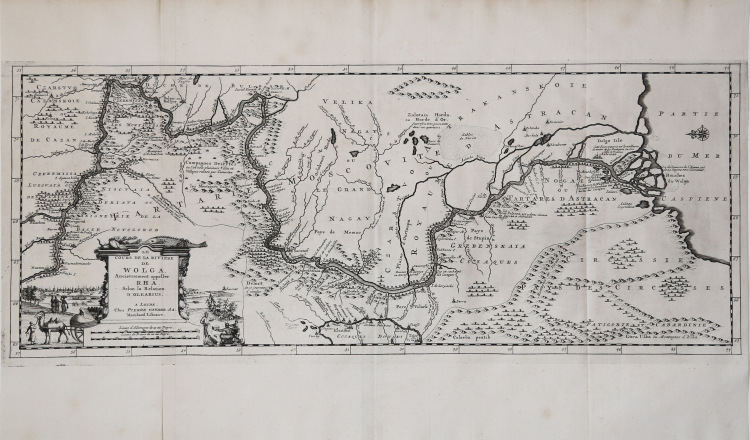




| Reference: | S48898 |
| Author | Pieter VANDER AA |
| Year: | 1720 ca. |
| Zone: | Course of the Volga |
| Printed: | Leyden |
| Measures: | 600 x 245 mm |



| Reference: | S48898 |
| Author | Pieter VANDER AA |
| Year: | 1720 ca. |
| Zone: | Course of the Volga |
| Printed: | Leyden |
| Measures: | 600 x 245 mm |
Beautiful example of the map of the Volga River by Adam Olearius (1603-1671), which first appeared in Relation du voyage d'Oléarius Adam en Moscovie, Tartarie, et Perse avec celui de I.A. De Mandelslo aux Indes Orientales - traduit de l'Allemand et augmenté par A. de Wicquefort. This example was republished in a smaller format by Pieter Vander Aa in 1729 in his Dutch translation of the Relation of Olearius
Olearius' map of the lower Volga is the most important 17th-century map of the area; richly decorated with views of a Russian wooden house with peasants gathering outside, a view of the city of Saratov, and a view of Astrakhan, the Persian city at the mouth of the Volga. Camels and a Tatar wagon appear in the foreground, where Tatar merchants display their goods.
Olearius was ambassador in Moscow and traveled to Persia in an attempt to secure a favorable position for Frederick III at the end of the Silk Road. He traveled extensively, meeting with the Tsar and the Shah: his descent of the Volga led to the first detailed mapping of the river. Olearius' account of the expedition, first published in German in 1646 and translated into French in 1656 and again in 1659, is one of the earliest and most important accounts of European travels in Russia. The map is based on a manuscript created by Olearius himself. When he returned to Moscow he presented it to Tsar Michael Romanov and was offered a position as court astronomer (which Olearius declined).
Olearius' mission as ambassador was to obtain permission to use the Volga as a trade route to Persia, so his accurate mapping of the route was vital. He observed that: “since in my opinion this river is one of the largest, longest and most remarkable in the world, I have assiduously explored it with the help of an experienced Dutch navigator, Cornelius Clausen, and some Russian sailors; and I have reduced it to a map with the aid of a compass, showing not only its course, bends, angles and shores, but also its depths so as to indicate where one can sail freely and safely, its sandbars, the islands in it and the countries along its shores; and I have measured distances in miles and even in versts”.
Etching, in excellent condition.
Pieter VANDER AA (1659 - 1733)
|
Records show that van der Aa, born in Leyden in 1659, made an early start in life by being apprenticed to a bookseller at the age of nine and starting on his own in business as a book publisher by the time he was twenty-three.
During the following fifty years he published an enormous amount of material, including atlases and illustrated works in every shape and size, two of them consisting of no less than 27 and 28 volumes containing over 3,000 maps and plates.
Most of his maps were not of the first quality and were certainly not original, but they are often very decorative and are collected on that account.
|
Pieter VANDER AA (1659 - 1733)
|
Records show that van der Aa, born in Leyden in 1659, made an early start in life by being apprenticed to a bookseller at the age of nine and starting on his own in business as a book publisher by the time he was twenty-three.
During the following fifty years he published an enormous amount of material, including atlases and illustrated works in every shape and size, two of them consisting of no less than 27 and 28 volumes containing over 3,000 maps and plates.
Most of his maps were not of the first quality and were certainly not original, but they are often very decorative and are collected on that account.
|